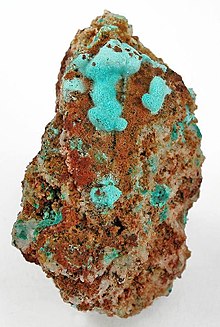| Mixite | |
|---|---|
 Turquoise-blue mixite, Laurium, Greece. Size: 6.8 x 5.0 x 3.6 cm. | |
| General | |
| Category | Arsenate mineral |
| Formula (repeating unit) | BiCu6(AsO4)3(OH)6·3(H2O) |
| IMA symbol | Mix[1] |
| Strunz classification | 8.DL.15 |
| Crystal system | Hexagonal |
| Crystal class | Dipyramidal (6/m) (same H-M symbol) |
| Space group | P63/m |
| Unit cell | a = 13.646(2) Å, c = 5.920(1) Å; Z = 2 |
| Identification | |
| Color | Blue to emerald-green, pale green, white |
| Crystal habit | Acicular crystals often in radial clusters |
| Fracture | Uneven |
| Mohs scale hardness | 3–4 |
| Luster | Vitreous |
| Streak | Pale green |
| Diaphaneity | Transparent to translucent |
| Specific gravity | 3.79–3.83 |
| Optical properties | Uniaxial (+) |
| Refractive index | nω = 1.743 – 1.749 nε = 1.810 – 1.830 |
| Birefringence | δ = 0.067 |
| Pleochroism | O = colorless, E = bright green |
| References | [2][3][4] |
Mixite is a rare copper bismuth arsenate mineral with formula: BiCu6(AsO4)3(OH)6·3(H2O). It crystallizes in the hexagonal crystal system typically occurring as radiating acicular prisms and massive encrustations. The color varies from white to various shades of green and blue. It has a Mohs hardness of 3.5 to 4 and a specific gravity of 3.8. It has an uneven fracture and a brilliant to adamantine luster.
It occurs as a secondary mineral in the oxidized zones of copper deposits. Associated minerals include: bismutite, smaltite, native bismuth, atelestite, erythrite, malachite and barite.[2]
It was discovered in 1879 near J´achymov, Czech Republic by mine engineer Anton Mixa.[5] Mixite has also been found in Argentina,[6] Australia,[7] Austria,[8] France,[9] Germany,[10] Greece,[11] Hungary,[12] Italy,[13] Japan,[14] Mexico,[15] Namibia,[16] Poland,[17] Spain,[18] Switzerland,[19] the United Kingdom,[20] and the United States.[21]
Mixite is the namesake member of the mixite mineral group, which has the general chemical formula Cu2+6A(TO4)3(OH)6·3H2O, where A is a REE, Al, Ca, Pb, or Bi, and T is P or As. In addition to mixite, this mineral group contains the isostructural minerals agardite-(Y),[22][23] agardite-(Ce),[24] agardite-(Nd),[25] agardite-(La),[26] calciopetersite,[27] goudeyite,[28] petersite-(Ce),[29] petersite-(Y),[23][30] plumboagardite,[31] and zálesíite.[32]